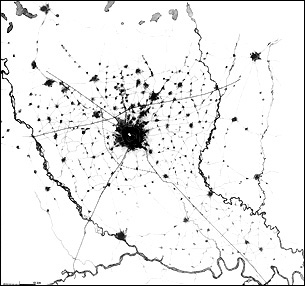Project for Milan and Lumbardy
by
VITTORIO MAZZUCCONI
Piano urbanistico per Milano, 1967
| BACK | HOMEPAGE | ARCHITECTURE | PAINTING | PHILOSOPHY | FOUNDATION |
| B.1.2.B2 |
| MEDIOLANUM Project for Milan and Lumbardy by VITTORIO MAZZUCCONI |
The City
In the Image and Resemblance of Man
(2/6) Piano urbanistico per Milano, 1967 |
| exploded into the super-development of science and technology, thus producing a mass society, with its brutality and its levelling to mere numbers. The splitting of man cannot but produce the absurd cities where we live, while it’s self evident that only a recomposition of such a split can open a new and authentic civilisation. The research regarding the new city that we hope to realize starts with a look at our inner life, its splitting, and aims at its possible recomposition in the image of a natural and balanced organism. If the book starts with the image of a plant, it then proceeds further with such comparisons, pointing out that many aspects of the city can make us think more of an animal, a very brutal one indeed, then of a vegetal. Going even further, the animal evolves towards man, and even beyond man or at least his higher expression. The study of these analogies can be very fruitful, as the deep structure of our organism and its development process from the embryo to birth, lead us to think new ideas about the city, ideas that have nothing in common with the ideologies and abstractions which have led astray the urbanism studies. Furthermore, in this kind of thought we don’t consider man as an abstract ideal, but we recognize in the family the first cell of society, very much like the houses being the cells of the city. There is a promising intuition, which runs through the book: it’s the intent of looking not only at the city but also at civilisation and the universe itself, as a whole that is in harmony and analogy with man, his organism, his ages, the development of his thought. This is a transcendent finality, which appears in his evolution as his very purpose, the raison d’etre of his life and of the whole universe. The “City at the Image and Resemblance of Man” clearly shows such a connection, not to say that this truly is an identity.
|
Second part In the same way in which a soul becomes incarnate in a body, the principle delineated above, made with thoughts, intuitions, and of a religious sentiment of life, decides to descend into a concrete reality in order to experience its transformation in its own image. To achieve this we ideally come back to the beginning of Milan’s history, when it was a cross-way of country paths in the middle of a plain: its ancient name, Mediolanum, means in fact “in the middle of the plain”.From the beginning, Milan is therefore a radial-concentric city, with a morphology similar to that of a plant or even a spider’s web: there are many radial-orientated roads and many circular ones. Even when the primitive village became a Roman city (as a matter of fact, the capital of its Empire in its last century), this basic feature was not modified. Furthermore, everything was left unaltered in the subsequent one thousand five hundred years; from the Roman town-walls to the Navigli canals, to the Spanish walls, to the ring-road of the present city, and, finally, a few pass-highways exterior to the city. Urbanists of our day have long considered this conformation as a banality and perhaps even a mistake to be corrected, whereas Vittorio Mazzucconi, opening himself to the inspiration of the form, but also to the profound meaning of this city's soul, has actually based the design of a new metropolis on this very mistake.  |